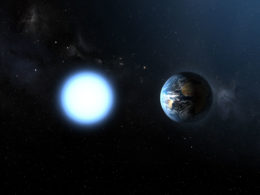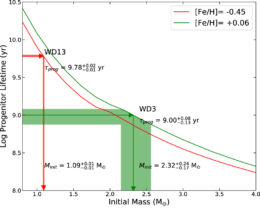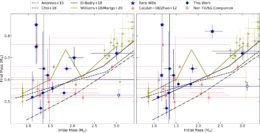When a star ends its main-sequence lifetime, loses its outer layers, and becomes a white dwarf, how massive will it be? Astronomers turn to white dwarfs’ binary companions to help answer this question.
A Frequent Finale

Stars with masses less than roughly eight solar masses leave behind their dense cores, which are approximately the same size as Earth but substantially more massive. This artist’s impression compares the size of Sirius B, the nearest white dwarf, to Earth’s size. [ESA/NASA]
Even though the vast majority of stars become white dwarfs, many questions remain about these compact stellar remnants. One lingering uncertainty is the connection between a star’s main-sequence mass and the mass of the white dwarf it leaves behind. Is the mass of the white dwarf correlated with the star’s main-sequence mass, or do other factors, like the star’s chemical makeup, play a defining role? Pinning down the initial-to-final mass relation can help us gain a better grasp on the intricacies of how stars make the tumultuous journey from the main sequence to their final phase.

Diagram of the white dwarf mass-determination process, shown for two white dwarfs in the sample. Stellar models (solid lines) allow progenitor star lifetimes to be mapped to initial stellar masses. [Barrientos & Chanamé 2021]
Companion Chronology
Manuel Barrientos and Julio Chanamé (Pontifical Catholic University of Chile) approached this question by studying white dwarfs that are separated by thousands of astronomical units from their binary companions. These widely separated binary systems are a useful tool for studying white dwarfs; the two stars in the binary system are likely to be the same age, and the wide separation makes it unlikely that the stars have exchanged mass, which could complicate their evolutionary tracks.
Barrientos and Chanamé used models of stellar evolution and parameters extracted from spectroscopic and photometric observations to determine the masses of the white dwarfs, how long ago they formed, and the ages of their stellar companions. They then used evolutionary models to link the main-sequence lifetime of the white dwarf’s progenitor star — determined by subtracting the lifetime of the white dwarf from the age of the companion star — to its mass.
Far-Reaching Implications

Initial and final masses of the stars in this work (blue symbols) and others. The two panels use different sets of stellar parameters. Click to enlarge. [Barrientos & Chanamé 2021]
The authors hope that future observations will refine the initial-to-final mass relationship further — the dispersion seen in their work isn’t predicted by models, cannot be fully explained by differences in stellar composition, and would have major implications for research that relies on precise determination of this relationship.
Citation
“Improved Constraints on the Initial-to-final Mass Relation of White Dwarfs Using Wide Binaries,” Manuel Barrientos and Julio Chanamé 2021 ApJ 923 181. doi:10.3847/1538-4357/ac2f49
